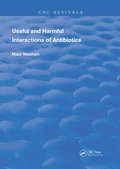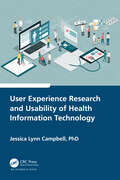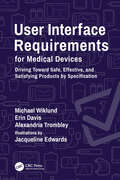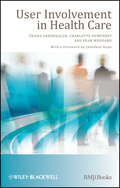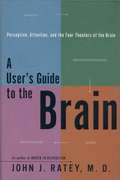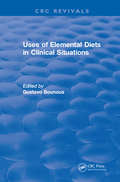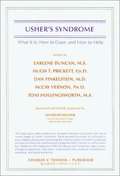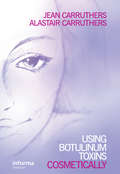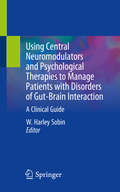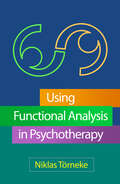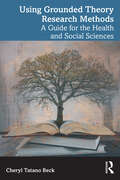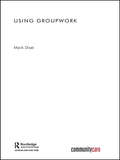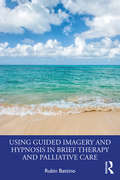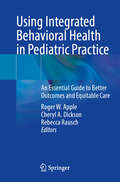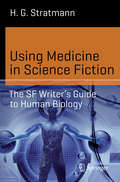- Table View
- List View
Useful and Harmful Interactions of Antibiotics (Routledge Revivals)
by Maur NeumanFirst published in 1987: This book is intended as a guide for a very large group of practitioners in the medical, pharmaceutical, and biological fields. It will enable them to prescribe and use antibiotics in an improved way.
User Experience Research and Usability of Health Information Technology
by Jessica Lynn CampbellHealth information technology (HIT) is a critical component of the modern healthcare system. Yet to be effective and safely implemented in healthcare organizations and physicians and patients’ lives, it must be usable and useful. User Experience (UX) research is required throughout the full system design lifecycle of HIT products, which involve a user-centered and human- centered approach. This book discusses UX research frameworks, study designs, methods, data-analysis techniques, and a variety of data collection instruments and tools that can be used to conduct UX research in the healthcare space, all of which involve HIT and digital health. This book is for academics and scholars to be used to design studies for graduate dissertation work, in independent research, or as a textbook for UX/usability courses in health informatics or related health information and communication courses. This book is also useful for UX practitioners because it provides guidance on how to design a user research or usability study and focuses on leveraging a mixed- methods approach, including step-by-step by instructions and best practices for conducting: Field studies Interviews Focus groups Diary studies Surveys Heuristic evaluation Cognitive walkthrough Think aloud A plethora of standardized surveys and retrospective questionnaires (SUS, Post-study System Usability Questionnaire (PSSUQ)) are also included. UX researchers and healthcare professionals will gain an understanding of how to design a rigorous, yet feasible study that generates useful insights to inform the design of usable HIT. Everything from consent forms to how many participants to include in a usability study has been covered in this book. The author encourages user-centered design (UCD), mixed-methods, and collaboration amongst interdisciplinary teams. Knowledge from many inter-related disciplines, like psychology, technical communication (TC), and human-computer interaction (HCI), together with experiential knowledge from experts is offered throughout the text.
User Innovation in Healthcare: How Patients and Caregivers React Creatively to Illness (SpringerBriefs in Health Care Management and Economics)
by Francesco SchiavoneThis book explores in depth the phenomenon of user innovation in healthcare. In particular, the book sheds light on patient innovation, whereby patients and/or caregivers proactively develop and diffuse new products and services that provide health and quality of life benefits by addressing gaps in existing market offerings. The aim is to clarify the key characteristics of these innovative processes and to offer practitioners and policymakers tangible bottom-up evidence, solutions, and ideas that will assist in improving health systems, organizations, and practices. A number of important and interesting research questions are addressed, casting light on the types of products and services that tend to be developed by patient innovators, the typical profile of these innovators, the role played by firms, institutions, and health professionals, and the ways in which digital technologies support the dissemination of innovations among patient communities and within the industry. Beyond academic scholars and policymakers, the book will be of high value for students on master’s programs in both medical sciences and business and economics.
User Interface Requirements for Medical Devices: Driving Toward Safe, Effective, and Satisfying Products by Specification
by Erin Davis Michael Wiklund Alexandria TrombleyThis book is a practical guide for individuals responsible for creating products that are safe, effective, usable, and satisfying in the hands of the intended users. The contents are intended to reduce the number of use errors involving medical devices that have led to injuries and deaths. The book presents the strong connection between user interface requirements and risk management for medical devices and instructs readers how to develop specific requirements that are sufficiently comprehensive and detailed to produce good results – a user-friendly product that is likely to be used correctly. The book’s tutorial content is complemented by many real-world examples of user interface requirements, including ones pertaining to an inhaler, automated external defibrillator, medical robot, and mobile app that a patient might use to manage her diabetes. The book is intended for people representing a variety of product development disciplines who have responsibility for producing safe, effective, usable, and satisfying medical devices, including those who are studying or working in human factors engineering, psychology, mechanical engineering, biomedical engineering, systems engineering, software programming, technical writing, industrial design, graphic design, and regulatory affairs.
User Involvement in Health Care
by Frcp Trisha Greenhalgh Charlotte Humphrey Fran Woodard Obe Ma Frcgp DProfHow can the needs and perspective of patients be incorporated in the design and redesign of health services? Health organizations are focusing more and more on patients – and requiring their employees to practise patient focused care. The Modernisation Initiative described in this book explores in three health service areas (kidney, stroke and sexual health services) how patients' and carers' involvement may inform and shape quality improvement work This book guides you through the issues and challenges that teams seeking to involve users in changing health services are likely to face. It offers a wealth of practical knowledge about involving users. Those undertaking similar programmes, whether in primary care or hospital based, will find ideas and examples in this book to inspire and guide them.
User's Guide to the Brain: Perception, Attention, and the Four Theaters of the Brain
by John J. RateyFor the first time ever, discoveries in our understanding of the brain are changing anthropology, linguistics, philosophy, and psychology--indeed, the brain itself may become a catalyst for transforming the very nature of these inquiries. In A User's Guide to the Brain, Dr. John Ratey, best-selling coauthor of Driven to Distraction, explains in lucid detail and with perfect clarity the basic structure and chemistry of the brain: how its systems shape our perceptions, emotions, actions, and reactions; how possession of this knowledge can enable us to more fully understand and improve our lives; and how the brain responds to the guidance of its user. He draws on examples from his own practice, from research, and from everyday life to illuminate aspects of the brain's functioning, among them prenatal and early childhood development; the perceptual systems; the processes of consciousness, memory, emotion, and language; and the social brain. As the best means for explaining the dynamic interactions of the brain, Ratey offers as a metaphor the four "theaters" of exploration: 1) the act of perception; 2) the filters of attention, consciousness, and cognition; 3) the array of options employed by the brain--memory, emotion, language, movement-to transform information into function; and 4) behavior and identity. Ratey succeeds not only in giving us a compelling portrait of the brain's infinite flexibility and unpredictability but also in demonstrating how our very understanding of the brain affects who we are.
Users' Guides to the Medical Literature: Essentials of Evidence-Based Clinical Practice (Second Edition)
by The Evidence-Based Medicine Working Group EditorsEvidence-based medicine involves the careful interpretation of medical studies and its clinical application. And no resource helps you do it better-and faster-than Users' Guides to the Medical Literature: Essentials of Evidence-Based Clinical Practice. This streamlined reference distills the most clinically-relevant coverage from the parent Users' Guide Manual into one highly-focused, portable resource. Praised for its clear explanations of detailed statistical and mathematical principles, The Essentials concisely covers all the basic concepts of evidence-based medicine--everything you need to deliver optimal patient care. It's a perfect at-a-glance source for busy clinicians and students, helping you distinguish between solid medical evidence and poor medical evidence, tailor evidence-based medicine for each patient, and much more. Now in its second edition, this carry-along quick reference is more clinically relevant--and more essential--than ever!
Uses of Elemental Diets in Clinical Situations
by G. BounousThe studies presented in this book demonstrate that a new concept in the management of carious intestinal disorders should be considered, namely, that common nutrients may protect or heal the mucosa by virtue of the particular form and mode in which they are delivered to the intestinal lumen and their availability to the mucosal cells. The substitution of intact protein in the formula by hydrolysate appears to me an important factor.
Usher's Syndrome: What It Is, How to Cope, and How to Help
by Earlene Duncan Hugh T. Prickett Dan Finkelstein Mccay Vernon Toni HollingsworthDescribes what Usher's syndrome is, how it impacts a person's life, and ways to cope with this dual disability.
Using Books in Clinical Social Work Practice: A Guide to Bibliotherapy
by Jean A PardeckUsing Books in Clinical Social Work Practice: A Guide to Bibliotherapy introduces clinical social workers and other helping professionals to bibliotherapy, an innovative approach to helping individuals deal with psychological, social, and developmental problems. Literally meaning “treatment through books,” bibliotherapy actively involves the client in the therapeutic process through the reading of carefully selected and evaluated books. With this guide, the therapy you give will provide information and insight, stimulate discussion, communicate new values and attitudes, create awareness that others have similar problems, and provide solutions to problems. Using Books in Clinical Social Work Practice offers a detailed approach for helping clinicians use bibliotherapy in practice. You’ll discover which types of problems best respond to bibliotherapy and you’ll learn how to select the most effective books to treat those problems. You’ll even find the structure of the book helpful, as it: introduces you to the basics of bibliotherapy provides a detailed examination of the techniques for using books in treatment reviews and analyzes the extensive research that has been conducted on bibliotherapy focuses on the problems most effectively treated with bibliotherapy--divorce and remarriage, dysfunctional families, parenting, adoption and foster care, self-development, serious illness, substance abuse offers an authoritative guide to over 300 books found to work most effectively--including summaries and levels of interest presents conclusions and a summary for the use of books in treatmentAlthough bibliotherapy is a well-established practice technique in other professions, including psychiatry and psychology, social work practitioners have not traditionally used bibliotherapy as part of their practice. Using Books in Clinical Social Work Practice gives today’s helping professional an approach to problem solving that you and your clients will find refreshing and effective.
Using Botulinum Toxins Cosmetically: A Practical Guide
by Jean Carruthers Alastair CarruthersBotox, or Botulinum toxin, has become a household word, not so much for its use as an exciting drug in almost every field of medicine, but as a deadly poison that has been somehow transformed into a softener of facial expression lines. When done correctly, the treatment can be safe, effective, and in comparison to other modalities, involves relativ
Using CNS Autopsy Tissue in Psychiatric Research: A Practical Guide
by Brian Dean Thomas M Hyde Joel E KleinmanEssential for the laboratory, this practical manual presents a wide variety of techniques associated with the use of human CNS tissue obtained at autopsy. The book contains detailed methodologies in discrete chapters written by an expert in the specific field. It also addresses the potential for extending molecular studies in brain tissue obtain
Using Central Neuromodulators and Psychological Therapies to Manage Patients with Disorders of Gut-Brain Interaction: A Clinical Guide
by W. Harley SobinThis guide provides a concise overview of central neuromodulators and psychological therapies, and their use in managing patients with disorders of gut-brain interaction. The text demonstrates how central neuromodulators can help disordered gut function and reviews choices of drugs for different disorders, along with dosages and recommendations on their use. The book also outlines the use of cognitive behavioral therapy and exposure therapy in treating these patients, and presents a tutorial on how internal medicine physicians should approach the use of psychiatric medications.Written by experts in the field, Using Central Neuromodulators and Psychological Therapies to Manage Patients with Disorders of Gut-Brain Interaction: A Clinical Guide is a valuable resource for clinicians and practitioners on how to treat and manage patients afflicted with disorders of gut-brain interaction.
Using Data Management Techniques to Modernize Healthcare
by MA, MHA, HopperHealthcare organizations with sound human resources (HR) infrastructures are better able to hire, develop, promote, and retain employees who match up well with their specific needs. Using Data Management Techniques to Modernize Healthcare explains how to modernize your HR systems through the use of artificial intelligence (AI), information technolo
Using Event-B for Critical Device Software Systems
by Neeraj Kumar SinghDefining a new development life-cycle methodology, together with a set of associated techniques and tools to develop highly critical systems using formal techniques, this book adopts a rigorous safety assessment approach explored via several layers (from requirements analysis to automatic source code generation). This is assessed and evaluated via a standard case study: the cardiac pacemaker. Additionally a formalisation of an Electrocardiogram (ECG) is used to identify anomalies in order to improve existing medical protocols. This allows the key issue - that formal methods are not currently integrated into established critical systems development processes - to be discussed in a highly effective and informative way. Using Event-B for Critical Device Software Systems serves as a valuable resource for researchers and students of formal methods. The assessment of critical systems development is applicable to all industries, but engineers and physicians from the health domain will find the cardiac pacemaker case study of particular value.
Using Functional Analysis in Psychotherapy
by Niklas TörnekeFilled with rich case examples, this book shows how psychotherapists from any orientation can use functional analysis (FA) to better understand their clients and specifically target the changes that clients seek. Extensive therapist–client dialogues illustrate ways to probe difficult emotions and explore the causes and consequences of behavior, with special attention to harnessing the power of metaphor. FA is a core component of such evidence-based treatments as dialectical behavior therapy, acceptance and commitment therapy, and behavioral activation, and is central to the growing movement toward process-based therapies in general. This is the English edition of Vägledning i klinisk funktionell analys, published in Swedish in 2023 and translated and revised by the author.
Using Grounded Theory Research Methods: A Guide for the Health and Social Sciences
by Cheryl Tatano BeckThis practical text introduces and compares all the different varieties of grounded theory for researchers new to the methodology from across the health and social sciences. Grounded theory is a complex research methodology, further complicated by the existence of a number of different variations.Method slurring is a common problem and this thoughtful textbook enables readers to understand and use grounded theory correctly, with chapters focusing on Barney Glaser’s grounded theory, Anselm Strauss and Juliet Corbin’s grounded theory, Leonard Schatzman and Barbara Bowers’ dimensional analysis, Kathy Charmaz’s constructivist grounded theory, and Adele Clarke’s situational analysis. It includes a comparison of first- and second-generation grounded theory approaches and includes an interdisciplinary selection of examples. Each chapter includes tips for researchers, activities, and a summary highlighting the strengths and limitations of the grounded theory approach in question.This text is an essential read for researchers with an interest in grounded theory or advanced students opting qualitative research methods courses.
Using Groupwork
by Mark DoelWritten by an experienced groupworker and academic, this book promotes greater knowledge and understanding of groupwork and group processes, particularly in social work and social care settings. Incorporating both theory and practice, it provides a practical guide to those considering groupwork, and further inspiration for those already involved. The book incorporates a number of case examples of groups run in mainstream social work, social care and multidisciplinary settings. Skills-based in approach, this original text includes: illustrative group examples quotes from groupworkers key learning points based on research activities to develop practice suggestions for further reading. Published in association with Community Care Magazine, the book meets the changing needs of today’s students and practitioners in social care and is a welcome addition to the current literature.
Using Guided Imagery and Hypnosis in Brief Therapy and Palliative Care
by Rubin BattinoUsing Guided Imagery and Hypnosis in Brief Therapy and Palliative Care presents a model for effective single-session therapy. Chapters include more than a dozen case studies with transcripts and commentary. Readers will learn how to use an adapted model of Remen’s healing circle for preparing patients for surgery, and guided imagery and other approaches are presented for enhancing palliative care. Extensive appendixes provide a wide variety of valuable tools that psychotherapists can use with clients concerned with end-of-life issues.
Using Health Policy in Nursing Practice (Transforming Nursing Practice)
by Georgina TaylorThis book is part of the Transforming Nursing Practice series, written specifically to support nursing students on the new degree programme. Health policy can appear complex and remote from nursing practice. This book demystifies health policy and helps you understand how policy decisions relate to your daily practice. Through the exploration of selected hot topics, such as patient involvement and dignity, the book helps you to consider how not only to use policy in practice, but also how to use practice to influence policy. Patient narratives and case studies are followed through each chapter to show how policy issues can impact on real life care. The book also shows how you can use an understanding of policy to develop your career. Key Features: - Shows how policy impacts on the real world and how you can use it to improve care or change practice - Regular activities help you to engage with policy issues - Enables you to see how to use policy in practice yourself - Supports you in meeting the NMC requirements for registration About the series Transforming Nursing Practice is the first series of books designed to help students meet the requirements of the NMC Standards and Essential Skills Clusters for the new degree programmes. Each book addresses a core topic, and together they cover the generic knowledge required for all fields of practice. Accessible and challenging, Transforming Nursing Practice helps nursing students prepare for the demands of future healthcare delivery. Series editor: Proffesor Shirley Bach, Head of the School of Nursing and Midwifery at the University of Brighton. Co-series editor for learning skills titles: Dr Mooi Standing, Independent Academic Consultant at national and international level, and an accredited Nursing and Midwifery Council (NMC) reviewer. Georgina Taylor was a Principal Lecturer in the School of Health and Social Sciences at Middlesex University for many years, and has recently retired. She taught research methods to a range of healthcare professionals and aspects of health policy and interprofessional working to third year nursing students. Research interests include the health of refugees and asylum seekers, health inequalities, intercultural care, and patient safety.
Using Hypnosis with Children: Creating and Delivering Effective Interventions
by Michael D. Yapko Lynn LyonsHow to create and deliver effective hypnotic interventions with children. From the initial interview to creating the best metaphors, Using Hypnosis with Children is a practical, step-by-step guide that shows health care providers (including therapists, nurses, pediatricians, dentists, and educators) how to create and deliver hypnotic interventions that are customized and effective into their pediatric clinical work, with utilization and flexibility as key components to an overall treatment approach. Using case examples of language for all age groups, readers learn first how to identify the salient targets or themes, deliver a session that hits these targets with precision, and then connect the session to the child's everyday experience. More broadly, readers learn to use hypnosis as a way to help create new neural pathways, teach self-regulation, introduce a more internal locus of control, and develop positive interpersonal experiences. Chapters focus on the most common issues that children face, including anxiety, depression, medical procedures/pain, and sleep.
Using Integrated Behavioral Health in Pediatric Practice: An Essential Guide to Better Outcomes and Equitable Care
by Roger W. Apple Cheryl A. Dickson Rebecca RauschIntegrated behavioral health plays a very important role in the pediatric practice. This book demonstrates that mental health, behavioral health, and psychology are an integral part of whole person medical care while helping to outline a path for the medical community to integrate behavioral health into their practices. A comprehensive description of integrated behavioral health for general pediatrics is described in the first section of this text. It includes recommended terminology definitions, advice on building an integrated health service, interventions, intersectionality, models of change, person centered treatment planning and the use of integrated behavioral health in residency training programs. The second section focuses on how health equity is improved utilizing integrated behavioral health. Subsequent chapter focuses include describing how integrating psychologists in pediatric practices improves health equity, discussing improved healthcare for transgender youth, inequities of ethnic minorities and improved care for patients with disabilities. The third and final section describes how pediatric subspecialties are improved using integrated behavioral health. Subspecialties included are endocrinology, allergy and immunology, gastroenterology, obesity and medical weight loss and sleep medicine. Written by experts in the field, Utilization of Integrated Behavioral Health in Pediatric Practice fills a much needed gap in medical literature by providing a comprehensive guide to integrated behavioral health, not only in pediatrics, but also pediatric subspecialties.
Using Knowledge and Evidence in Health Care
by Louise Lemieux-Charles François ChampagneAt the clinical, management, and policy levels, the use of knowledge and evidence in health care has become a worldwide priority. The contributors to Using Knowledge and Evidence in Health Care seek to broaden our understanding of the complexity involved in health care decision-making by integrating social science knowledge and exploring some of the challenges and limits of evidence in different health care contexts.Louise Lemieux-Charles and François Champagne have brought together an esteemed group of scholars to provide a conceptual framework that illustrates the factors critical to analysing and optimizing the use of knowledge and evidence. Previous studies have focused primarily on the medical literature without acknowledging the social sciences tradition. With its integration of works from political science, public policy, informatics, and other disciplines, Using Knowledge and Evidence in Health Care provides a bridge between both worlds. By bringing together different views on the topic, the volume goes beyond strict disciplinary boundaries to provide the fullest exploration of knowledge and evidence in health care.
Using Mass Spectrometry for Drug Metabolism Studies
by Walter A. KorfmacherThe first edition of this now classic work helped to establish mass spectrometry as the premier tool for drug metabolism studies. Completely rewritten from start to finish, Using Mass Spectrometry for Drug Metabolism Studies, Second Edition brings medicinal chemists and mass spectrometry professionals up to speed with the rapid advances in the fiel
Using Medicine in Science Fiction
by H. G. StratmannThis book offers a clearly written, entertaining and comprehensive source of medical information for both writers and readers of science fiction. Science fiction in print, in movies and on television all too often presents dubious or simply incorrect depictions of human biology and medical issues. This book explores the real science behind such topics as how our bodies adapt to being in space, the real-life feasibility of common plot elements such as suspended animation and medical nanotechnology, and future prospects for improving health, prolonging our lives, and enhancing our bodies through technology. Each chapter focuses on a single important science fiction-related subject, combining concise factual information with examples drawn from science fiction in all media. Chapters conclude with a "Bottom Line" section summarizing the most important points discussed in the chapter and giving science fiction writers practical advice on how to incorporate them into their own creations, including a list of references for further reading. The book will appeal to all readers interested in learning about the latest ideas on a variety of science fiction-related medical topics, and offers an invaluable reference source for writers seeking to increase the realism and readability of their works. Henry G. Stratmann, MD, FACC, FACP is a cardiologist with board certifications in internal medicine, cardiology, and nuclear cardiology. Befor e entering private practice he became Professor of Medicine at St. Louis University School of Medicine and performed clinical medical research. Henry received a BA in chemistry from St. Louis University and his MD at Southern Illinois University School of Medicine. He is currently enrolled at Missouri State University to obtain a BS in physics with a minor in astronomy. His professional publications include being an author or coauthor of many research articles for medical journals, primarily in the field of nuclear cardiology. Henry is also a regular contributor of both stories and science fact articles to Analog Science Fiction and Fact.
